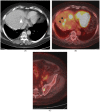Imaging Considerations before and after Liver-Directed Locoregional Treatments for Metastatic Colorectal Cancer
- PMID: 38611685
- PMCID: PMC11011364
- DOI: 10.3390/diagnostics14070772
Imaging Considerations before and after Liver-Directed Locoregional Treatments for Metastatic Colorectal Cancer
Abstract
Colorectal cancer is a leading cause of cancer-related death. Liver metastases will develop in over one-third of patients with colorectal cancer and are a major cause of morbidity and mortality. Even though surgical resection has been considered the mainstay of treatment, only approximately 20% of the patients are surgical candidates. Liver-directed locoregional therapies such as thermal ablation, Yttrium-90 transarterial radioembolization, and stereotactic body radiation therapy are pivotal in managing colorectal liver metastatic disease. Comprehensive pre- and post-intervention imaging, encompassing both anatomic and metabolic assessments, is invaluable for precise treatment planning, staging, treatment response assessment, and the prompt identification of local or distant tumor progression. This review outlines the value of imaging for colorectal liver metastatic disease and offers insights into imaging follow-up after locoregional liver-directed therapy.
Keywords: Yttrium-90 radioembolization; colorectal cancer; imaging; interventional oncology; liver metastases; locoregional therapy; margin; stereotactic body radiation therapy; thermal ablation.
Conflict of interest statement
The authors declare no conflicts of interest.
Figures






References
-
- Bailey C.E., Hu C.-Y., You Y.N., Bednarski B.K., Rodriguez-Bigas M.A., Skibber J.M., Cantor S.B., Chang G.J. Increasing Disparities in the Age-Related Incidences of Colon and Rectal Cancers in the United States, 1975–2010. JAMA Surg. 2015;150:17. doi: 10.1001/jamasurg.2014.1756. - DOI - PMC - PubMed
-
- Meijerink M.R., Puijk R.S., van Tilborg A.A.J.M., Henningsen K.H., Fernandez L.G., Neyt M., Heymans J., Frankema J.S., de Jong K.P., Richel D.J., et al. Radiofrequency and Microwave Ablation Compared to Systemic Chemotherapy and to Partial Hepatectomy in the Treatment of Colorectal Liver Metastases: A Systematic Review and Meta-Analysis. Cardiovasc. Interv. Radiol. 2018;41:1189–1204. doi: 10.1007/s00270-018-1959-3. - DOI - PMC - PubMed
Publication types
Grants and funding
LinkOut - more resources
Full Text Sources

